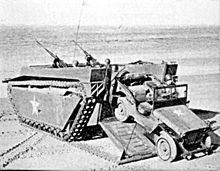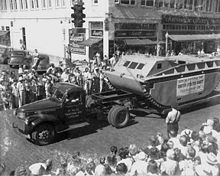
Back LVT Breton Landing Vehicle Tracked Czech Landing Vehicle Tracked German Vehículo de desembarco de tracción por orugas Spanish Landing Vehicle Tracked French LVT–1 Hungarian Landing Vehicle Tracked Italian LVT Japanese საბრძოლო სადესანტო მანქანა Georgian 상륙장갑차 Korean
This article has multiple issues. Please help improve it or discuss these issues on the talk page. (Learn how and when to remove these template messages)
|
| Amphibious Vehicle, Tracked | |
|---|---|
 LVT-4 unloading a Jeep | |
| Type | Amphibious vehicle |
| Place of origin | United States |
| Production history | |
| Manufacturer | Borg-Warner Food Machinery Corporation Graham-Paige Roebling St. Louis Car Company |
| Produced | July 1941 – August 1945 |
| No. built | 18,616 of all variants LVT-1.......7,225 LVT-2.......2,960 LVT(A)-2..450 LVT-3.......2,962 LVT-4.......8,348 LVT-4(A)-1..509 LVT(A)-4..1,890 LVT(A)-5..269 |
| Specifications (LVT-4) | |
| Mass | 36,400 lb (16,500 kg) |
| Length | 26 ft 1 in (7.95 m)[1] |
| Width | 10 ft 8 in (3.25 m) |
| Height | 8 ft 2 in (2.49 m) |
| Crew | 2–3 |
| Passengers | Up to 24 |
| Armor | 1⁄4 to 1⁄2 inch (6.4 to 12.7 mm) if added |
Main armament | 2 × pintle-mounted 0.50 in Browning M2HB machine guns |
Secondary armament | 2 × pintle-mounted .30-06 Browning M1919A4 machine guns Various small infantry arms (when carrying assault troops) |
| Engine | Continental W-670-9A; 7 cylinder, 4 stroke, air-cooled gasoline radial aircraft engine 250 hp (190 kW) |
| Power/weight | 15.2 hp/t |
| Payload capacity | 9,000 lb (4,100 kg) if unarmored[2] |
| Transmission | Spicer manual transmission, 5 forward and 1 reverse gears[1] |
| Suspension | Rubber torsilastic |
| Fuel capacity | 140 US gallons (530 L) |
Operational range | 150 mi (240 km) on road, 75 mi (121 km) in water |
| Maximum speed | 20 mph (32 km/h) on land, 7.5 mph (12.1 km/h) in water |
| LVT(A)-4 | |
|---|---|
 LVT(A)-4 amtank at Iwo Jima beach, c. February/March 1945. | |
| Specifications | |
| Mass | 40,000 lb (18,000 kg) |
| Length | 26 ft 1 in (7.95 m) |
| Width | 10 ft 8 in (3.25 m) |
| Height | 10 ft 2.5 in (3.112 m) |
| Crew | 6 (commander, gunner, loader, driver, assistant driver, AA machine gunner) |
| Armor | 1⁄4 to 1+1⁄2 in (6.4 to 38.1 mm) |
Main armament | 1 × 75 mm M2/M3 Howitzer |
Secondary armament | 3 × .30-06 Browning M1919A4 machine gun |
| Engine | Continental W-670-9A; 7 cylinder, 4 cycle, radial gasoline 250 hp (190 kW) |
| Power/weight | 13.9 hp/t |
| Transmission | Spicer manual transmission, 5 forward and 1 reverse gears |
| Suspension | Rubber torsilastic |
| Fuel capacity | 106 US gallons (400 L) |
Operational range | 200 km (road), 120 km (water) |
| Maximum speed | 40 km/h (25 mph), in water 11 km/h (6.8 mph) |



The Amphibious Vehicle, Tracked (LVT) is an amphibious warfare vehicle and amphibious landing craft, introduced by the United States Navy and United States Marine Corps. (The USN and USMC use "L" to designate Amphibious vessels, also called "L class".) The United States Army, Canadian Army and British Army used several LVT models during World War II, and referred to those vehicles as "Landing Vehicle, Tracked."
Originally intended solely as cargo carriers for ship to shore operations, they evolved into assault troop and fire support vehicles. The types were known as amphtrack, "amtrak", "amtrac", etc. (portmanteaus of "amphibious tractor"), and "alligator" or "gator".
- ^ a b Icks 1970, p. 16
- ^ Olive Drab: Amphibious Vehicle, Tracked (Armored) LVT(A) in World War II olive-drab.com, accessed 11 November 2021
© MMXXIII Rich X Search. We shall prevail. All rights reserved. Rich X Search